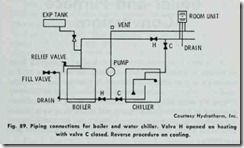BOILER REPAIRS
Repairs to the boiler itself should be done by an experienced and skilled worker. They should never be attempted while the boiler is under pressure. Shut down the boiler and allow it to cool.
Most structural repairs should be regarded as only .temporary until the section or part can be replaced with a new one. Minor cracks or leaks can be repaired as follows:
1. Minor cracks in the sections of a cast-iron boiler can be repaired by welding or brazing.
2. Boiler leaks can be temporarily sealed with a synthetic compound similar to the type used to seal automobile radiators. Permanent repairs should be made by an ex perienced worker.
BOILER INSULATION
All uninsulated boilers suffer a certain amount of heat loss. In some respects, this loss of heat can be beneficial, because it does warm the basement and the floor above. However, if the boiler is also used to provide domestic or commercial service hot water, this heat loss can be uneconomical. This is particularly true for the summer months.
Steel jacketed type boilers are generally insulated by the man ufacturer. For example, the boiler illustrated in Fig .3 is insulated with a 1 inch thick layer of fiberglass insulation attached to the inside surface of the steel jacket. However , other types of boilers, particularly the old cast-iron round boilers , do require an external layer of insulation to reduce the amount of heat loss. Only a non combustible material such as asbestos cement , asbestos paper, or magnesia blocks should be u sed for this purpose.
Magnesia blocks or sheets can be cut to fit the contours of a boiler, and wired to the surface. The cracks and insulating ma terial are then covered with asbestos cement. Corrugated asbestos paper can be used in place of magnesia block, but it should be applied in three layers to obtain the desired thickness (about 1’4 inch). Each layer should be covered with asbestos c ment.
Boiler Installation
All new boilers are shipped with a complete set of installation instructions. Usually these instructions will also contain an in ventory list of the contents in the crates and cartons. Always check the contents off against this list before you do anything
else. Missing or damaged parts should be immediately reported to the manufacturer or his local representative.
A boiler should always be located so that the connecting flue pipe between the boiler (or draft diverter) and the chimney is as short as possible. Another important consideration are the recom mended minimum clearances between the boiler and combustible materials. These two factors plus the design considerations of the system will dictate where the boiler is located.
The manufacturer’s installation guide will also contain in structions on how to light and operate .the boiler. The instructions will differ in accordance with the type of automatic fuel burning equipment used (e.g. oil burner, gas burner, etc.).
After completing .the installation of the boiler, inspect all the controls to make certain they are operating properly. Start and stop the burner or stoker several times by moving the room .ther mostat setting.
An important point to remember is that any and all require ments of national standards and codes, as well as local authorities having jurisdiction, always take precedence over the installation instructions provided by the manufacturer. For example, the latest edition of the American National Standard for Installation of Gas Appliances and Gas Piping Z21.30 should be consulted when installing gas-fired boilers.
WATER CHILLERS
One method of adding central air conditioning to a structure heated by either hot water or steam is to install a water chiller. A water chiller is a device consisting of a compressor, a con denser, a thermal expansion valve, and a refrigerant evaporator coil enclosed in a steel shell. The water in the system is pumped through the shell, where it is cooled by the evaporator coil, and circulated through the radiators or convectors for cooling and dehumidification.
The boiler and water chiller are available packaged in a single unit, or they may be installed as separate units. In a hot-water heating system, the same piping can be used to carry both the hot water and chilled water to the radiators or convectors. The room radiators or convectors are individualy controlled to permittemperature adjustments. Steam piping should not be used to carry the chilled water.
Few residential water chillers are in use. The most popular method of applying central air conditioning to a steam or hot water space heating system is to install a split system.
When a water chiller is installed as a separate unit, the chilled water should be piped in parallel with the boiler. Appropriate valves should be installed to prevent the chilled water from enter ing .the boiler (Fig. 89).
